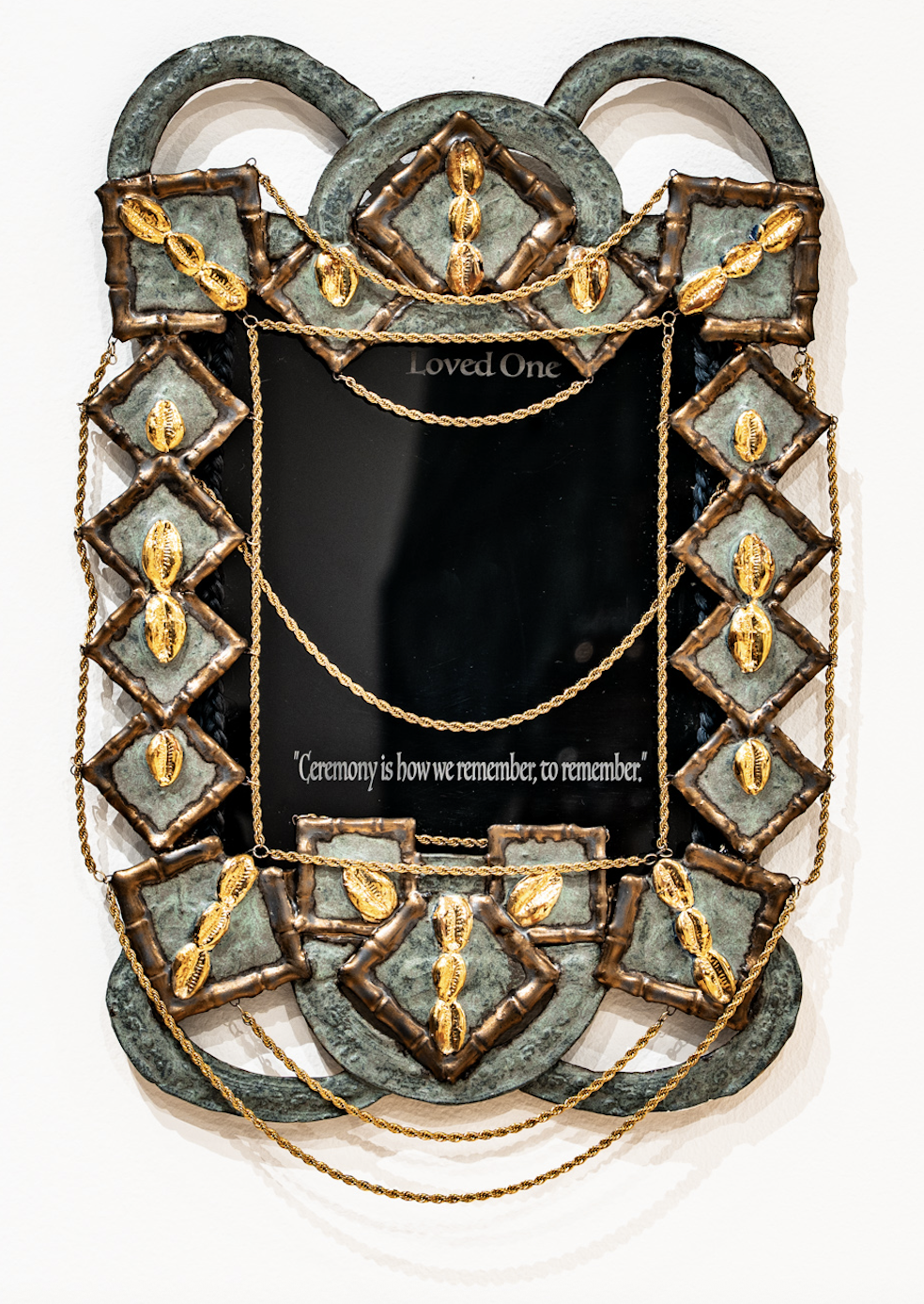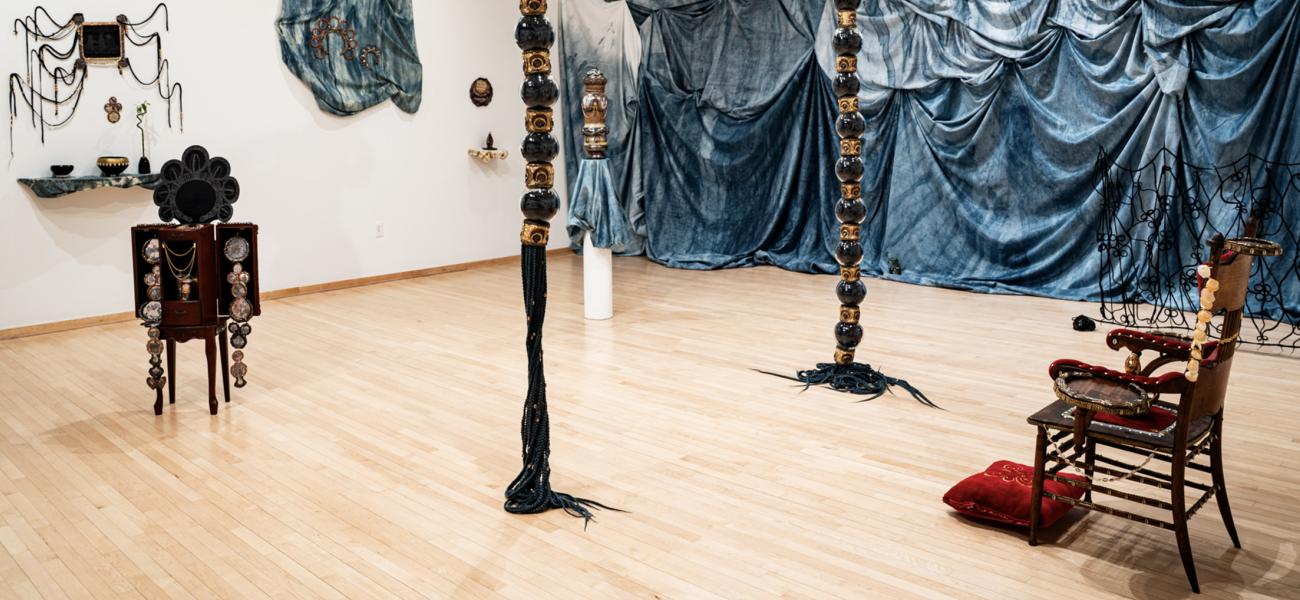Verve: Black Extravagance in Angelique Scott’s Ceramics
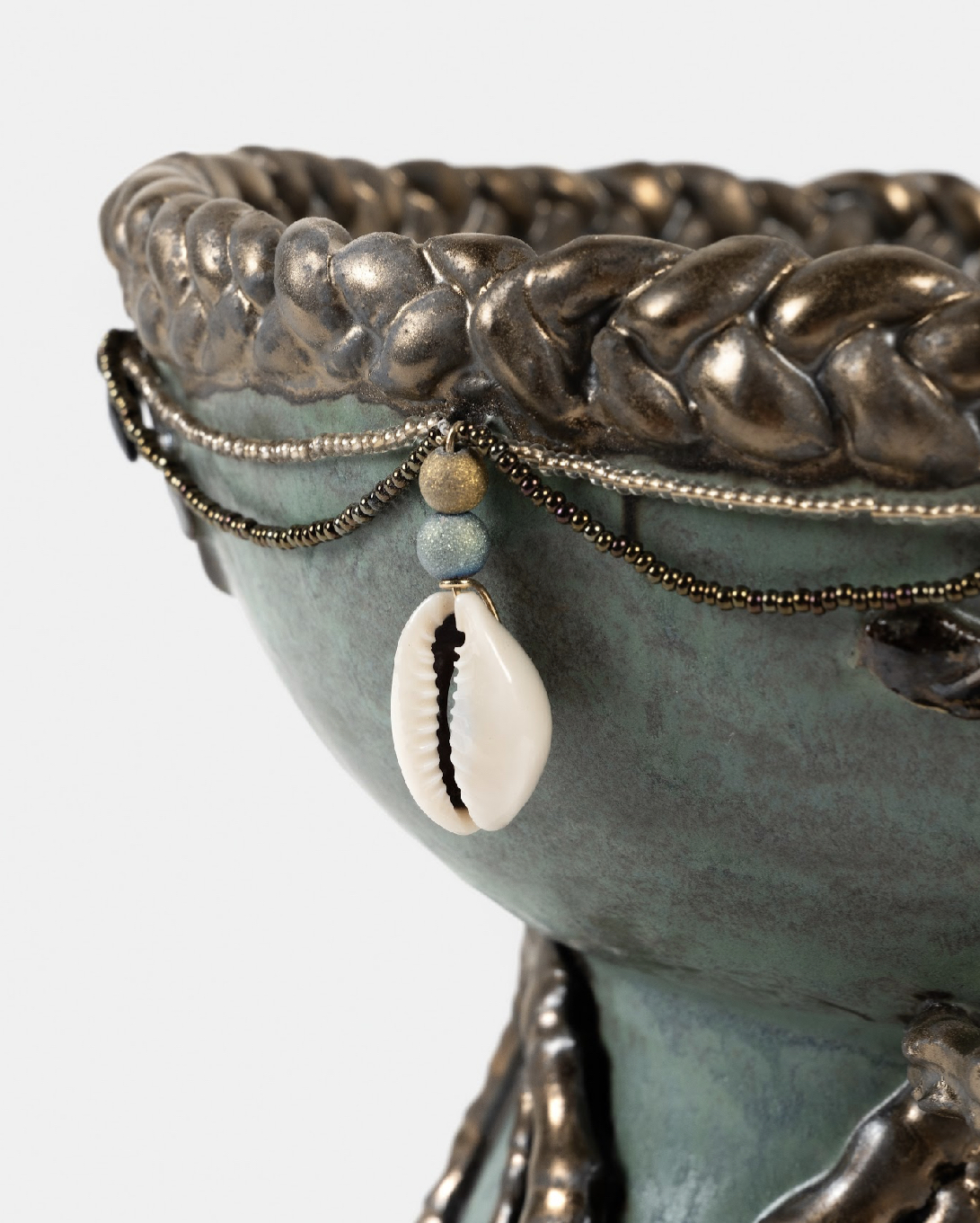 From doorknocker earring chalices, glossy surfaces of cowries dipped in an abalone-like glaze, a nod to the cosmos, and laser-cut pithy sayings by Black women on mirrors, there’s an indisputable flyness. Historically, hidden within our most familiar forms, deeper messages emerge. This isn’t just art – it’s sacred Black feminist praxis, glazed and fired with purpose. Crowned testimony to the fact that Black girls have always been art, have always been theory, have always been enough. Her work is loud in the way we’ve been taught to hush, soft in the way we’ve been taught to harden. It refuses the binaries – function or ornament, domestic or political, beauty or resistance, and instead insists on all of it. What she does with clay is nothing short of conjure work – pulling memory from the marrow, shaping it into something you can touch, witness, and praise.
From doorknocker earring chalices, glossy surfaces of cowries dipped in an abalone-like glaze, a nod to the cosmos, and laser-cut pithy sayings by Black women on mirrors, there’s an indisputable flyness. Historically, hidden within our most familiar forms, deeper messages emerge. This isn’t just art – it’s sacred Black feminist praxis, glazed and fired with purpose. Crowned testimony to the fact that Black girls have always been art, have always been theory, have always been enough. Her work is loud in the way we’ve been taught to hush, soft in the way we’ve been taught to harden. It refuses the binaries – function or ornament, domestic or political, beauty or resistance, and instead insists on all of it. What she does with clay is nothing short of conjure work – pulling memory from the marrow, shaping it into something you can touch, witness, and praise.
Vessel
Scott’s vessels speak in tongues – glazed dialects of memory, beauty, and refusal. In Offering Bowl 1 (2025), the shallow curvature of the bowl suggests both openness and withholding, like hands cupped to receive or a mouth mid-sentence. Her use of cowries across these vessels isn’t decorative flourish; it’s code. These shells, long used as currency, adornment, and oracles in West African traditions, signify an enduring Black femininity that is rich, resourceful, and resistant.
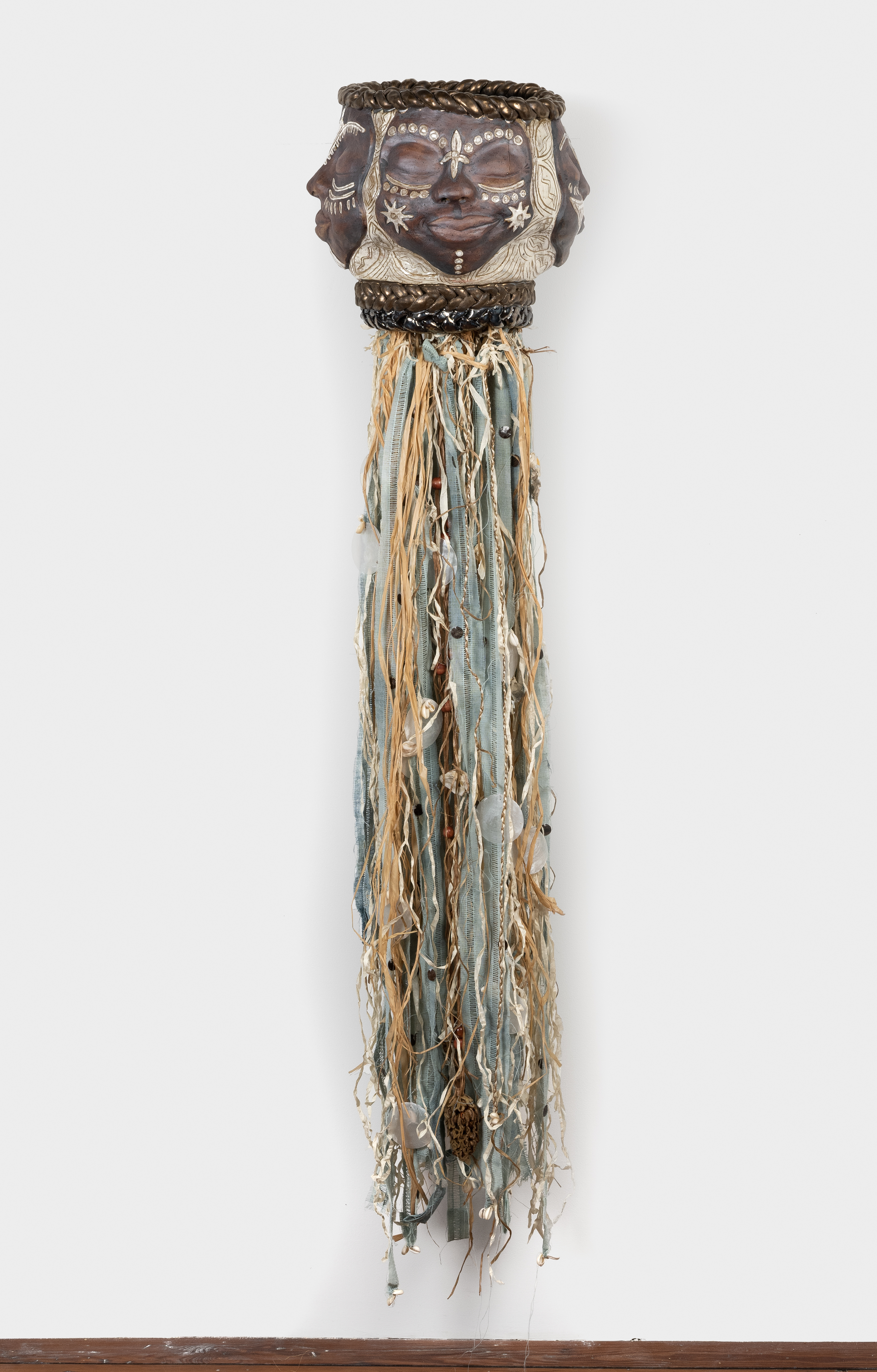 Spirit Guides (2022) has a face on each side of the vessel. The grooves between the faces echo the marks of scarification, mapping ancestral lines and rites of passage. Each figure’s smiling, closed eyes are adorned with what resembles warpaint – symbols of both defiance and delight. Rather than offering a singular portrait, Scott renders multiple visages into one form, collapsing time and individual identity into a communal presence. These faces do not confront the viewer; they emanate inward joy, serenity, and knowing.
Spirit Guides (2022) has a face on each side of the vessel. The grooves between the faces echo the marks of scarification, mapping ancestral lines and rites of passage. Each figure’s smiling, closed eyes are adorned with what resembles warpaint – symbols of both defiance and delight. Rather than offering a singular portrait, Scott renders multiple visages into one form, collapsing time and individual identity into a communal presence. These faces do not confront the viewer; they emanate inward joy, serenity, and knowing.
There’s something deeply architectural about the way the faces encircle the pot: like a pillar of testimony, they hold each other up. In that way, Spirit Guides becomes less a portrait and more a procession – an offering vessel animated by Black women’s multitudes. Its surface tells stories without words as if the clay itself remembers laughter, lullabies, and last breaths. Scott fires clay with emotional density, not just technical skill. The vessel’s tactile ridges – pinched, carved, burnished – invite not just sight, but touch. It’s a reminder that Black memory isn’t just passed down intellectually; it’s felt in the body, inherited through gesture, ritual, and ornament.
Gold and Verdigris Crowned Vase (2022) is a quadruple-decked vase with dangling cowrie shells and braids defining each level of the vase. Its elaborate ornamentation and large size indicate that it’s less of an everyday functional pot and more of a ceremonial object. The layered braids echo both architectural cornices and styles passed down through generations of kitchen-table braiding rituals. By crowning the vase with verdigris and gold, Scott transforms patina and shines into metaphor: aged knowledge and ever-glimmering beauty. In her hands, the vessel becomes a theological object – something to behold and be held by.
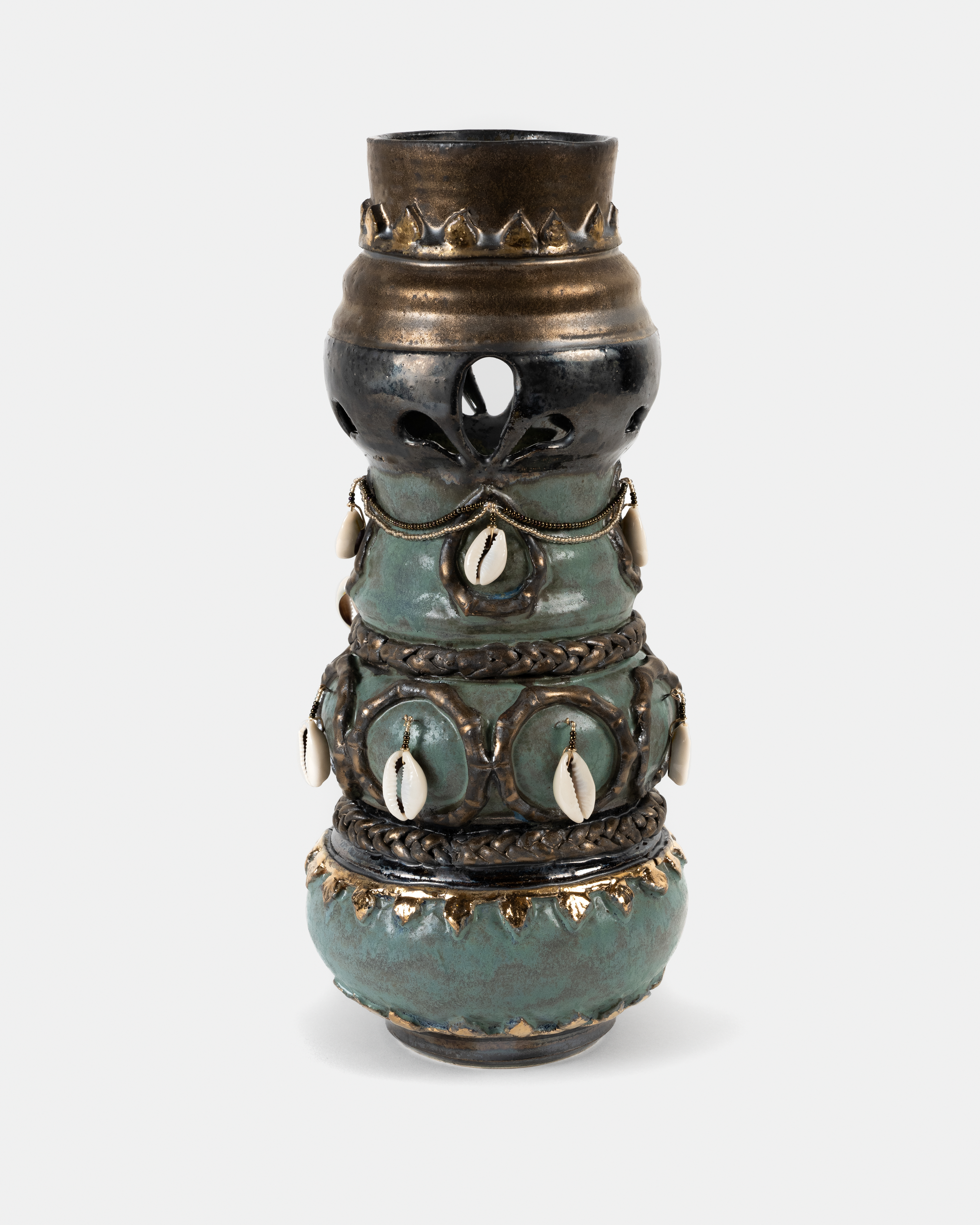 .
. 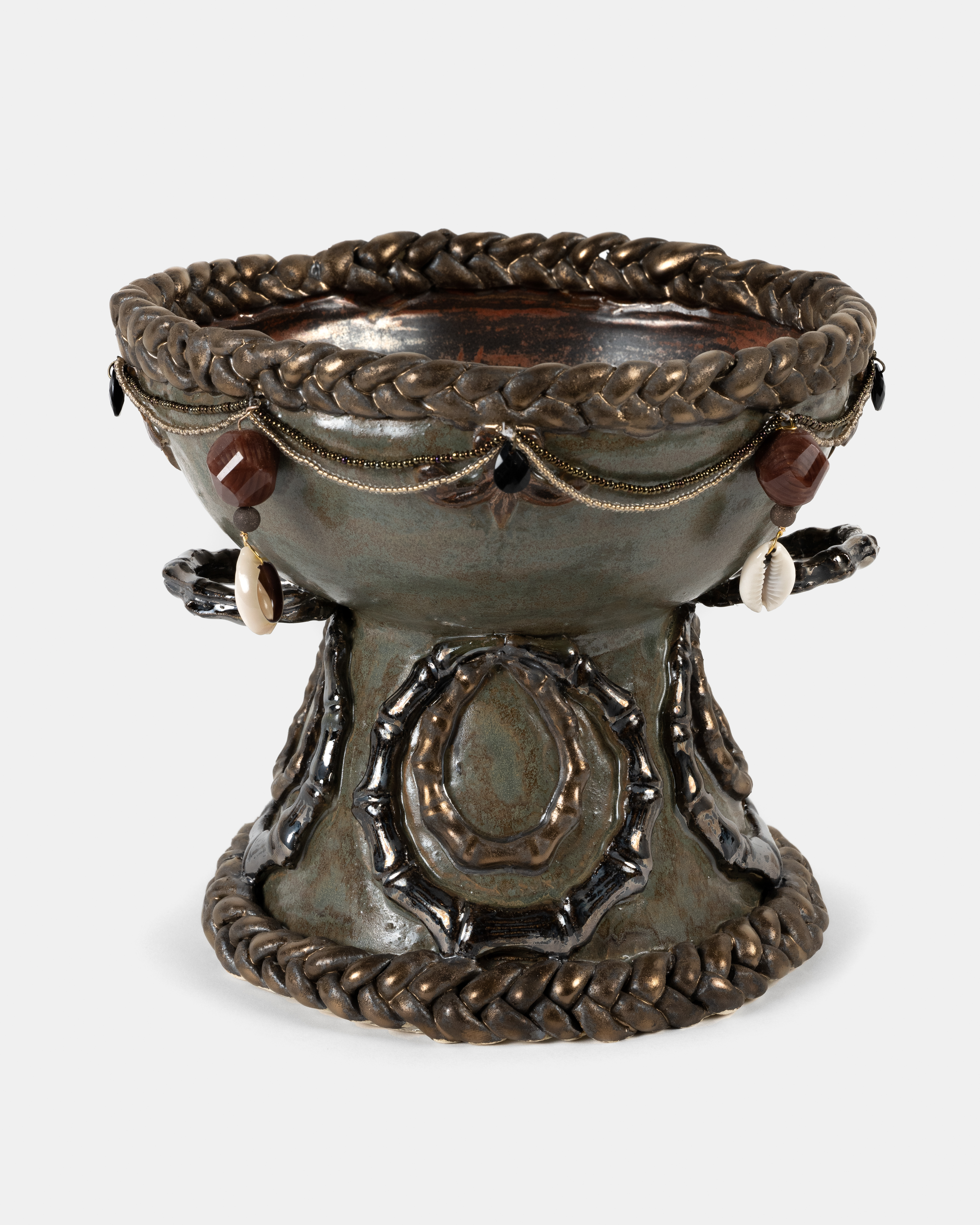
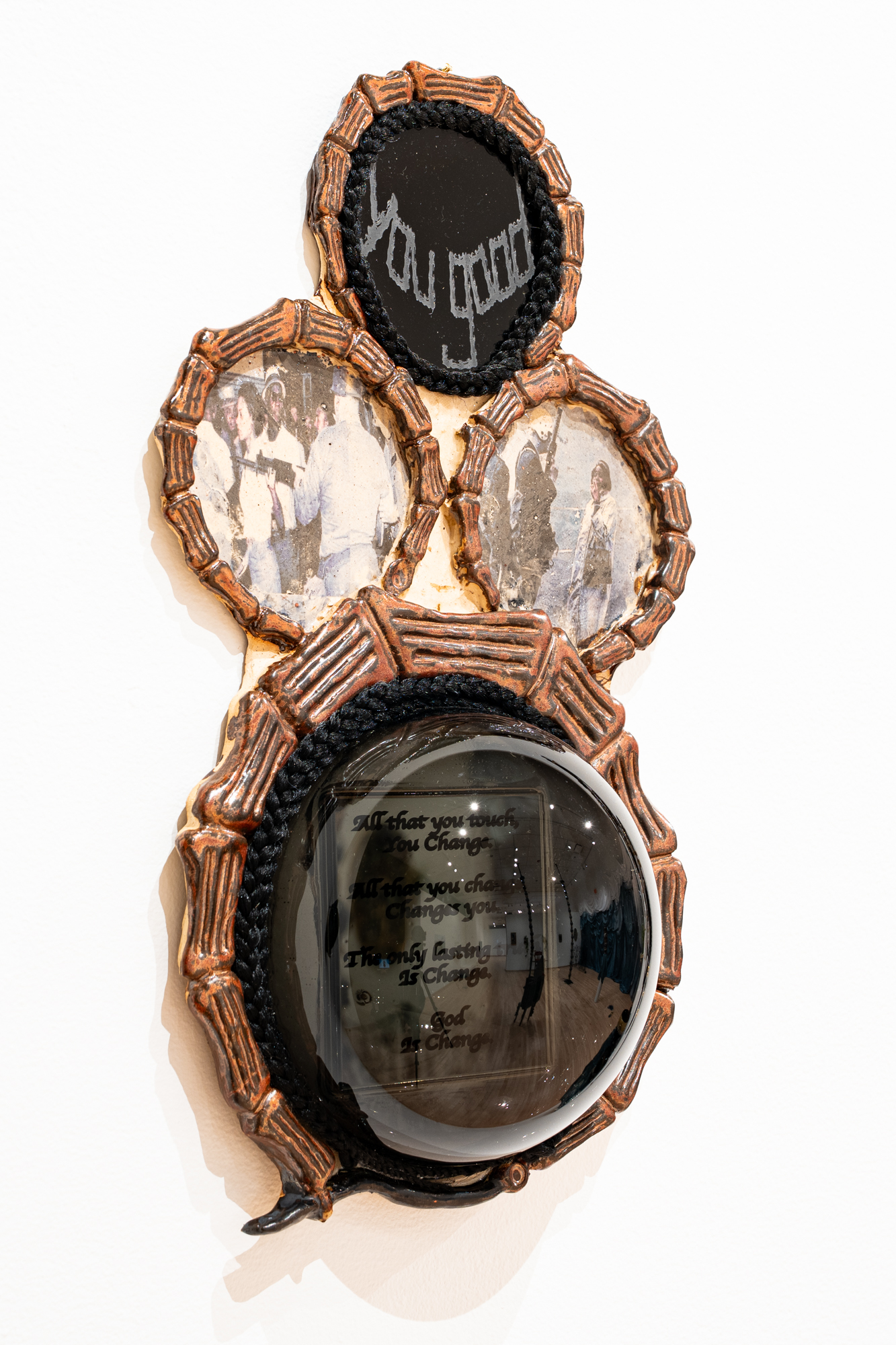 The Orb
The Orb
Using the language of the orb, a cosmic spherical form, Scott brings mysticism and Afrofuturism into the conversation. In Translation: IWAMFW (2025), the acronym standing for I Wish a Mother F*cker Would, bamboo earring framed photo transfers of Gloria Richardson pushing aside the national guard in Maryland in 1963 and Louise Jenkins Merriweather smoking a cigarette looking unbothered in 1957 in the face of police, a circle with the rhetorical “you good” and a black orb that looks like a beady iris affixed to the wall is framed by a braid form and a bamboo earring one. All these elements are arranged in a honeycomb-like pattern. Behind the black glass orb with just enough transparency to look behind is a laser-etched reflective mirror with the text: “All that you touch, you change.” She seamlessly combines glass and clay; something reflective and manufactured, and something of the earth, together in conversation. This work reminds us of the magic within Black women’s ‘no’ just as much as a ‘yes.’ When I studied Simone Leigh’s work, she made these busts of femme figures without eyes, indicating looking inward. Instead, Scott decides to represent this all-seeing eye with the orb, evoking that meeting the gaze is defiant, an act of gumption.
Whether in the previous work or a stand-alone, Scott includes many mirrors with affirmations carved into them with a laser cutter. The significance of these reflective surfaces is that they implicate the viewer. It reaffirms bell hooks’ statement: “The one person who will never leave us, whom we will never lose, is ourselves. Learning to love our female selves is where our search for love must begin.” She goes on to say, “I think that the truth is that finding ourselves brings more excitement and well-being than anything romance has to offer.”
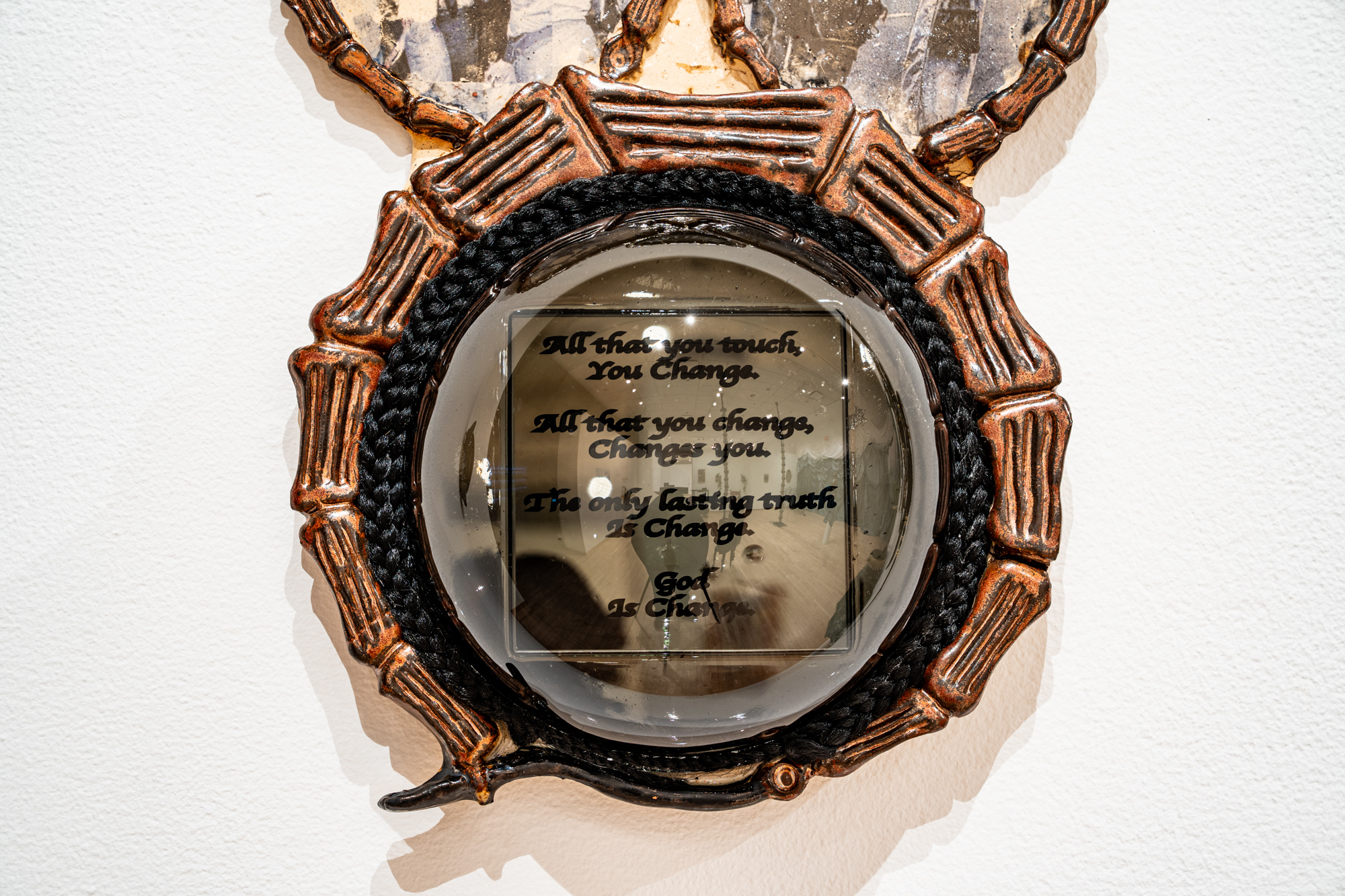
Hairloom (2024) suspends a constellation of clear glass orbs from the ceiling, reflecting a high sheen, echoing the luster of freshly oiled hair. They hover like planets, beads, or prayers mid-air, linked by golden accents, coils of synthetic hair, and sculpted glass forms that descend to the floor in twisting, vine-like lines. The glass itself feels like an infinite staff. This choice – the fragility and strength of glass incorporated in the composition – embodies the tension between delicacy and durability that defines Black femme survival.
Glass, like hair, can be manipulated, stretched, curled, and adorned, but only with skill and care. In Hairloom, Scott leverages that parallel to elevate the everyday into the ceremonial. The transparency of the glass plays with light in a way that makes the pillar-like structures feel alive – shifting in tone throughout the day, catching glimmers, casting shadows. Where synthetic hair pools below in abundance, the glass braid carries its lineage, fragile but unyielding, a ghostly echo of touch and technique.
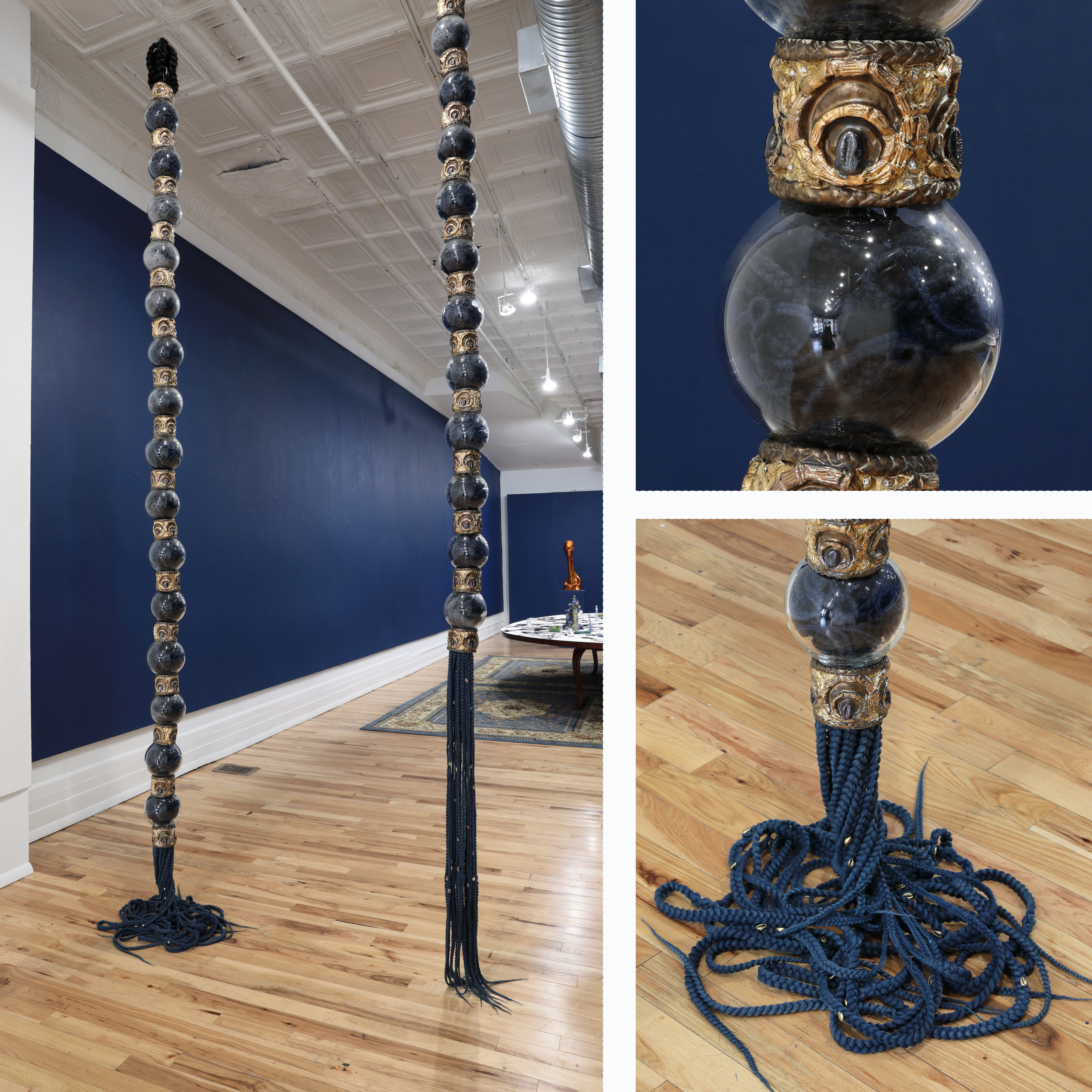 This isn’t just a sculpture, it’s a sacred geometry of Black adornment. The ceramic orbs resemble braid beads, yes, but they also evoke planets or memory knots, binding the spiritual to the sensual, the cosmic to the communal. Hairloom becomes chandelier and root system at once – radiant, grounded, reaching.
This isn’t just a sculpture, it’s a sacred geometry of Black adornment. The ceramic orbs resemble braid beads, yes, but they also evoke planets or memory knots, binding the spiritual to the sensual, the cosmic to the communal. Hairloom becomes chandelier and root system at once – radiant, grounded, reaching.
The piece emerges from Scott’s Hariarchy series, a body of work that interrogates the politics and poetics of Black hair as both archive and architecture. In Hairloom, she weaves lineage through materials: the industrial (synthetic hair), the elemental (glass and clay), and the ornamental (gold cuffs, cowries). By suspending these materials in space, Scott draws attention to the labor of beauty, the time it takes to braid, twist, and adorn – not as drudgery, but as a sacred offering.
What’s more, Hairloom invites viewers to look up, to tilt their heads, and shift their perspective. That act alone, the invitation to look with reverence, challenges the flattening gaze often placed upon Black femininity. Instead, Scott conjures a moment of collective witnessing: to remember hair not as spectacle, but as story, sculpture, and shimmering evidence of care.
Fellowship
Fellowship in Scott’s work isn’t a footnote; it’s form. Her installations and assemblages insist on presence, on being in community with the ones who shaped us and the ones yet to come. In her thesis show, Who All Gon Be There…, she crafts a visual and spatial chorus – a liturgy of belonging. The title itself is culled from the colloquial Black vernacular used to gauge safety, kinship, and intention. Who All Gon Be There is the threshold – at once invitation and challenge. A place to call in the ones who’ve always adorned us, held us, made us shine. A reminder that beauty, like memory, is best when shared.
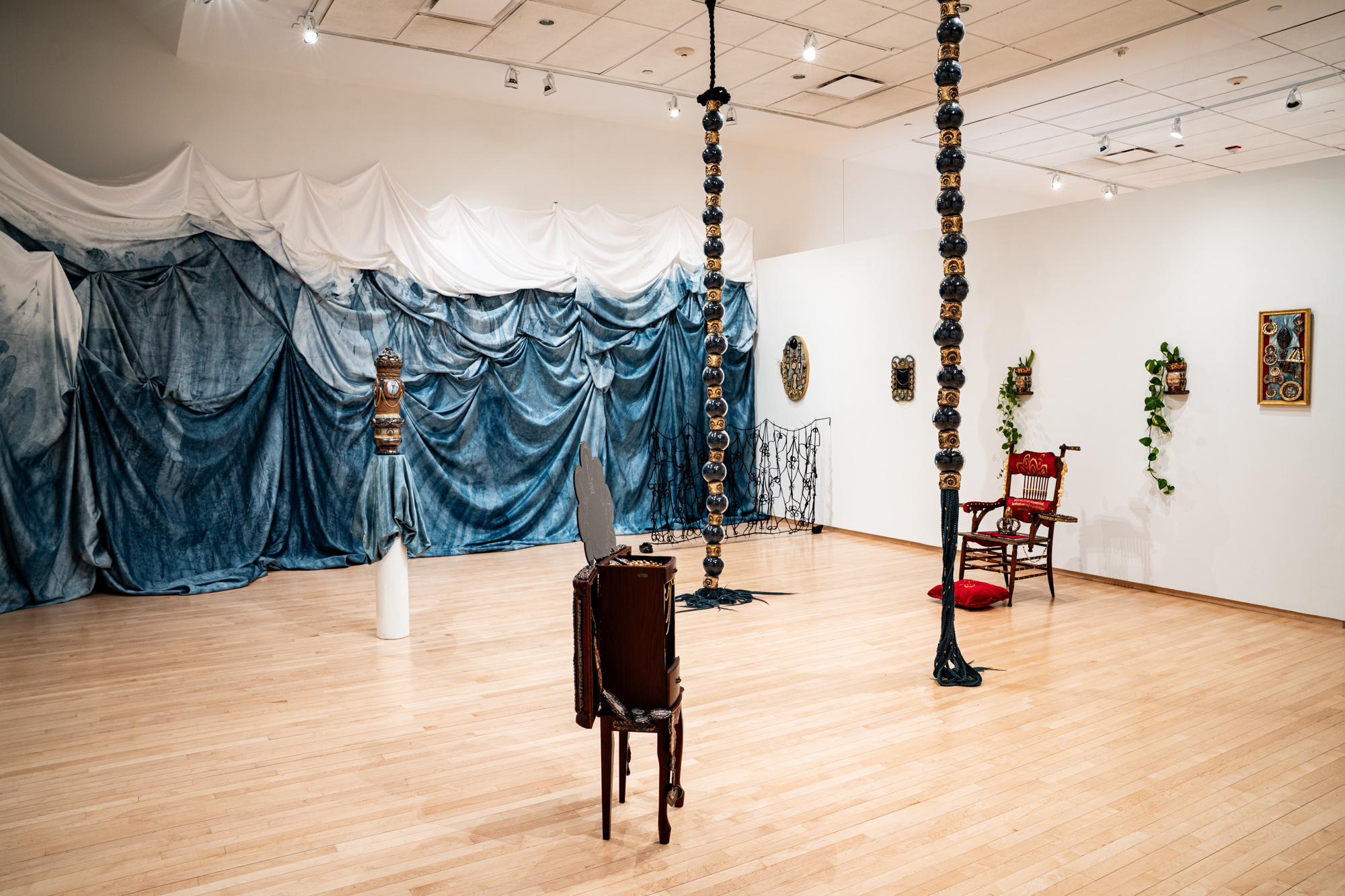 .
. 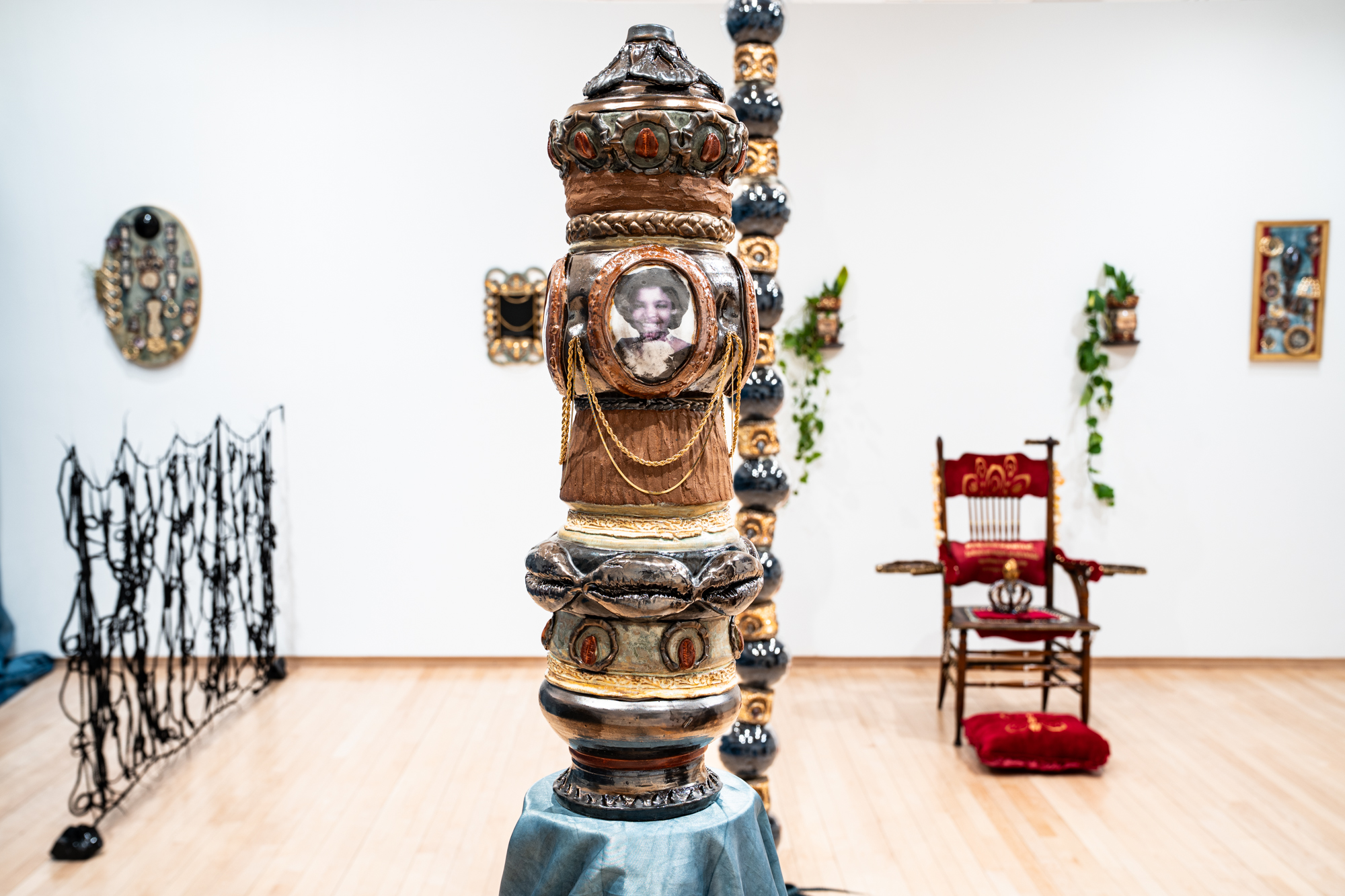
Chairs, thrones really, show up repeatedly – cowrie-adorned, braided, sometimes mirrored – signaling sovereignty and communion. These are not passive seating arrangements but testaments to Black women’s right to take up space, be seen, and be revered. Her chair forms often recall Yoruba ancestral altars or the regalia of Black Southern churches: part functional, part sacred. When she places these beside mirror plaques inscribed with affirmations, the viewer is invited into a ritual. To sit, to reflect, to remember oneself as worthy.
Scott's ceramic language refuses the individualist myth. Her work is chorus, cipher, and collective memory vessel. Whether through a bowl or a braid, a chair or a mirror, her practice is a call-and-response with foremothers, femmes, and fellow travelers. In her own words, “I love to create objects and spaces that I wish existed,” and through them, she births a new architecture of belonging. There is verve in every gesture: the gloss of a cowrie, the gleam of mirrored text, glass mimicking the movement of the braid. Her work moves with spirit and style – Black extravagance not as excess, but as epistemology. It is ornament as ontology, a language of form that says: we’ve always been here, always been fly, always been enough.
